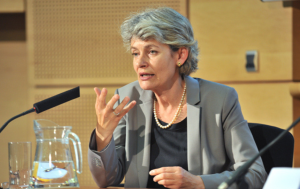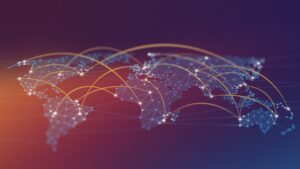Andrea Gómez, Jim Craig, Philippe Cousin, Pieter De Jong, Spiros Mazarakis, and Val De Oliveira from the FIWARE Community elaborate on how FIWARE is driving the development of smart digital solutions in a faster, easier, interoperable and affordable way that avoids vendor lock-in scenarios, following an open source approach.
When we talk about smart cities, information and communications technology, big data and the internet of things often spring to mind, and rightfully so. However, the scope of smart cities reaches far beyond software, hardware and data alone. Smart cities represent distinctive ecosystems of collaborative frameworks (private and public businesses, not-for-profit organisations, social enterprises, citizens and so on) that facilitate the transformation of cities into enablers of economic growth, innovation and well-being.
Under this concept, cities become more efficient, resilient to environmental challenges, cost-effective and sustainable, providing citizens with a better place to work, live and socialise. In this context, we invite you on a journey of digital transformation with practical examples focused on sustainability, data economy and the efficient management of public services – from a citizen standpoint – that showcase how FIWARE Foundation members are guiding cities and helping them to embrace the smart city concept.
Amersfoort, Antwerp, Málaga and Santander are just a few of the more than 150 cities that are part of the Open & Agile Smart Cities (OASC) network, of which the vast majority have already adopted FIWARE technologies. They’re great examples of how cities can boost growth and deliver more efficient services with the help of the growing FIWARE Community, ultimately creating more livable environments where both citizens and businesses can thrive.

FIWARE Smart Cities Architecture; Image provided courtesy of FIWARE Foundation
The current outlook and future challenges
Reports from the United Nations forecast that the world’s population will reach 9.8 billion by 2050, and 68 per cent of us will live in cities. These figures will place stress on infrastructure that is already struggling with a range of challenges, including pollution, congestion, poverty, waste, health care, energy and transportation. The deepening climate crisis intensifies matters with increases in the frequency and severity of extreme weather events.
The opportunity
Concentrating citizens into large “smart” metropolitan areas makes for economies of scale. For cities to become truly smart they require fundamental changes. Silos need removing, interoperability is key, and cities need to facilitate third parties to develop solutions to be used by city administrators to deliver services to citizens. Ultimately, it is about enhancing the delivery of services that support life events to citizens, literally from cradle to grave.
How do we get there?
Some “smart” examples exist today. For city administrators, it’s important to start with the a big picture, and deliver against that in smaller, incremental pieces. Building Smart World models (made entirely of Lego bricks) can be a good place to start. Some critical factors to deliver this approach in collaboration with trusted partners are:
• A modular architecture using open standards
• A rock-solid foundation
• An enabling ecosystem
A modular architecture allows you to start small, grow and adapt quickly. The foundation has to be secure, scalable, intelligent, distributed, extensible, resilient, responsive, support innovation and be backed by enterprise grade support at all times. You can learn how one city, Montevideo (a strategic user of the FIWARE platform and a member of the FIWARE Foundation) achieved its success with Red Hat here.

Smart Cities are not only about technology
Do you need a successful smart city approach that can address, for example, climate resilience, air and water pollution, public health and the liveability of cities? Then focus on the challenges of the city. Be open, build a community and collaborate.
At the heart of a city is its community, and a city’s community can provide invaluable input for working towards a smart city. Bringing together citizens, industry, science and policy is a potent mix for innovation. The key is to foster collaboration between all of these, while not trying to reinvent the wheel. A prerequisite for successful collaboration is openness: open data, open technology, open source, open standards. The technology is a facilitator, an enabler, a means to an end.
This is the approach of the Future City Foundation, the FIWARE iHub in the Netherlands, and the first smart city network in the Netherlands that focuses on the demand of the city and brings all contributors together.
SCOREwater is a successful project already applying this approach. SCOREwater focuses on enhancing the resilience of cities against climate change and urbanisation by enabling a water-smart society powered by digitalisation, linking the physical and digital world. In Barcelona (Spain), sewage is being monitored (as shown in the below image) by the initiative, and the data is analysed as part of a broader citizen-centric approach. All this data allows for faster and better-informed real-time decision-making.

There is much more. Embrace the collaborative approach, and learn more about the Future City Foundation.
Smarter cities to live in
As traditional city models are becoming obsolete, municipalities look towards restructuring and transformational projects. Smart, digital operational features and back-office systems are of utmost importance for the creation of a smart ecosystem. Based on its local government information management systems and FIWARE’s open source framework, Uni Systems has created the intelligent and integrated City2Live Urban Platform, which contributes to the creation of the cities of the future.
From mobility and parking to waste management, City2Live facilitates the optimal management and monitoring of the moving parts of a city – the result is something very different to the traditional, monolithic cities of the past. By capitalising on its strategic partnership with FIWARE, Uni Systems delivers strategic guidance to municipal governing bodies in their decision-making processes, helping to secure the efficient use of all public resources.

For more information on how Uni Systems is helping municipalities to deliver their digital vision and accommodate their citizens, click here.
A breath of fresher air
Among its other climate-related initiatives, the EU Green New Deal establishes the need for new investment models that mitigate greenhouse gas emissions. But before emissions can be reduced and air quality improved, establishing indicators to measure progress is key. ICTs can help accomplish this in many ways. There are many potential areas of application, including digital transport solutions, decentralised energy systems and smart climate-neutral communities.
Climate change mitigation is a global challenge, and evidence-based plans are crucial to make it effective. HOPU meets this challenge with its AI, IoT and FIWARE-based solutions for public administrations, simplifying the decision-making process aimed at reducing pollution in cities. This service allows cities to collect, analyse and visualise a large amount of environmental data from sources such as air quality sensors, utilities and social data. Currently in use, for example, in Madrid, Cartagena, and La Palma (Spain), as well as Bruges and Mechelen (Belgium), the solution offers clear indicators to facilitate the understanding of the environmental state within cities.

Data without context are meaningless
To address the many EU Green New Deal challenges, more intelligent analysis needs to be carried out, which will consequently lead to the collection of (big) data sets. This often also stimulates the deployment of IoT for the provision of key data.
There is a growing tendency to collect and accumulate data, with data holders proud to showcase their data sets. However, the bad news for them is that it will be hard to exploit the true power of that data if no emphasis is placed on the validity of the data itself, the data models or additional information such as semantics, which has the potential to turn data into powerful assets.
To enable the power of data, Easy Global Market (EGM), in line with the FIWARE open source model and the ETSI NGSI-LD specification, has developed an intelligent and context-aware data broker, Stellio. It was ETSI, the European Telecommunications Standards Institute, and a strategic partner of FIWARE, that once stated “data without context are meaningless”, and we could not agree more.







